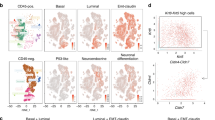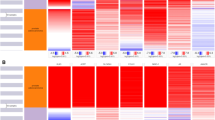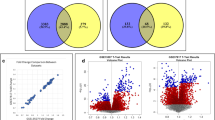Abstract
Many cell types have no known functional attributes. In the bladder and prostate, basal epithelial and stromal cells appear similar in cytomorphology and share several cell surface markers. Their total gene expression (transcriptome) should provide a clear measure of the extent to which they are alike functionally. Since urologic stromal cells are known to mediate organ-specific tissue formation, these cells in cancers might exhibit aberrant gene expression affecting their function. For transcriptomes, cluster designation (CD) antigens have been identified for cell sorting. The sorted cell populations can be analyzed by DNA microarrays. Various bladder cell types have unique complements of CD molecules. CD9+ urothelial, CD104+ basal and CD13+ stromal cells of the lamina propria were therefore analyzed, as were CD9+ cancer and CD13+ cancer-associated stromal cells. The transcriptome datasets were compared by principal components analysis for relatedness between cell types; those with similarity in gene expression indicated similar function. Although bladder and prostate basal cells shared CD markers such as CD104, CD44 and CD49f, they differed in overall gene expression. Basal cells also lacked stem cell gene expression. The bladder luminal and stromal transcriptomes were distinct from their prostate counterparts. In bladder cancer, not only the urothelial but also the stromal cells showed gene expression alteration. The cancer process in both might thus involve defective stromal signaling. These cell-type transcriptomes provide a means to monitor in vitro models in which various CD-isolated cell types can be combined to study bladder differentiation and bladder tumor development based on cell-cell interaction.







Similar content being viewed by others
Abbreviations
- CB:
-
Bladder cancer
- CD:
-
Cluster designation
- EC:
-
Embryonal carcinoma
- ES:
-
Embryonic stem
- MACS:
-
Magnetic cell sorting
- MIAME:
-
Minimum information about a microarray experiment
- NB:
-
Normal bladder
- PCA:
-
Principal components analysis
References
Aaboe M, Marcussen N, Jensen KM, Thykjaer T, Dryskjøt L, Orntoft TF (2005) Gene expression profiling of noninvasive primary urothelial tumors using microarrays. Br J Cancer 93:1182–1190
Aboseif S, El-Sakka A, Young P, Cunha G (1999) Mesenchymal reprogramming of adult human epithelial differentiation. Differentiation 65:113–118
Bonkhoff H, Remberger K (1996) Differentiation pathways and histogenetic aspects of normal and abnoraml prostatic growth: a stem cell model. Prostate 28:98–106
Choi YL, Lee SH, Kwon G, Park C, Han J, Choi JS, Choi HY, Kim S, Shin YK (2007) Overexpression of CD24, association with invasiveness in urothelial carcinoma of the bladder. Arch Pathol Lab Med 131:275–281
Cunha GR, Alarid ET, Turner T, Donjacour AA, Boutin EL, Foster BA (1992) Normal and abnormal development of the male urogenital tract. Role of androgens, mesenchymal-epithelial interactions, and growth factors. J Androl 13:465–475
Fleischmann A, Schlomm T, Huland H, Köllermann J, Simon P, Mirlacher M, Salomon G, Chun FHK, Steuber T, Simon R, Sauter G, Graefen M, Erbersdobler A (2008) Distinct subcellular expression patterns of neutral endopeptidase (CD10) in prostate cancer predict diverging clinical courses in surgically treated patients. Clin Cancer Res 14:7838–7842
Goldstein AS, Huang J, Guo C, Garraway IP, Witte ON (2010) Identification of a cell of origin for human prostate cancer. Science 329:568–571
Goo YA, Goodlett DR, Pascal LE, Worthington KD, Vessella RL, True LD, Liu AY (2005) Stromal mesenchyme cell genes of the human prostate and bladder. BMC Urol 5:17
Hu P, Meyers S, Liang FX, Deng FM, Kachar B, Zeidel ML, Sun TT (2002) Role of membrane proteins in permeability barrier function: uroplakin ablation elevates urothelial permeability. Am J Physiol Renal Physiol 283:F1200–F1207
Irizarry RA, Hobbs B, Collin F, Beazer-Barclay YD, Antonellis KJ, Scherf U, Speed TP (2003) Exploration, normalization, and summaries of high density oligonucleotide array probe level data. Biostatistics 4:249–264
Kanematsu A, Yamamoto S, Ogawa O (2007) Changing concepts of bladder regeneration. Int J Urol 14:673–678
Kristiansen G, Denhert C, Schluns K, Dahl E, Pilarsky C, Hauptmann S (2002) CD24 is expressed in ovarian cancer and is a new independent prognostic marker of patient survival. Am J Pathol 161:1215–1221
Lee JH, Kim SH, Lee ES, Kim YS (2009) CD24 overexpression in cancer development and progression: a meta-analysis. Oncol Rep 22:1149–1156
Li Y, Liu W, Hayward SW, Cunha GR, Baskin LS (2000) Plasticity of the urothelial phenotype: effects of gastrointestinal mesenchyme/stroma and implications for urinary tract reconstruction. Differentiation 66:126–135
Liu AY, True LD (2002) Characterization of prostate cell types by CD cell surface molecules. Am J Pathol 160:37–43
Liu AY, True LD, LaTray L, Nelson PS, Ellis WJ, Vessella RL, Lange PH, Hood L, Engh G van den (1997) Cell-cell interaction in prostate gene regulation and cytodifferentiation. Proc Natl Acad Sci USA 94:10705–10710
Liu AY, Roudier MP, True LD (2004) Heterogeneity in primary and metastatic prostate cancer as defined by cell surface CD profile. Am J Pathol 165:1543–1556
Marzolf B, Deutsch EW, Moss P, Campbell D, Johnson MH, Galitski T (2006) SBEAMS-Microarray: database software supporting genomic expression analyses for systems biology. BMC Bioinformatics 7:286
Murali R, Delprado W (2005) CD10 immunohistochemical staining in urothelial neoplasms. Am J Clin Pathol 124:371–379
Oottamasathien S, Wang Y, Williams K, Franco OE, Wills ML, Thomas JC, Saba K, Sharif-Afshar A, Makari JH, Bhowmick NA, DeMarco RT, Hipkens S, Magnuson M, Brock JW, Hayward SW, Pope JC, Matusik RJ (2007) Directed differentiation of embryonic stem cells into bladder tissue. Dev Biol 304:556–566
Oudes AJ, Campbell DS, Sorensen CM, Walashek LS, True LD, Liu AY (2006) Transcriptomes of human prostate cells. BMC Genomics 7:92
Pascal LE, Deutsch EW, Campbell DS, Korb M, True LD, Liu AY (2007) The urologic epithelial stem cell database (UESC)—a web tool for cell type-specific gene expression and immunohistochemistry images of the prostate and bladder. BMC Urol 7:19
Pascal LE, True LD, Campbell DS, Deutsch EW, Risk M, Coleman IM, Eichner LJ, Nelson PS, Liu AY (2008) Correlation of mRNA and protein levels: cell type-specific gene expression of cluster designation antigens in the prostate. BMC Genomics 9:246
Pascal LE, Goo YA, Vêncio RZN, Page LS, Chambers AA, Liebeskind ES, Takayama TK, True LD, Liu AY (2009a) Gene expression down-regulation in CD90+ prostate tumor-associated stromal cells involves potential organ-specific genes. BMC Cancer 9:317
Pascal LE, Vêncio RZN, Goo YA, Page LS, Shadle CP, Liu AY (2009b) Temporal expression profiling of the effects of secreted factors from prostate stromal cells on embryonal carcinoma stem cells. Prostate 69:1353–1365
Pascal LE, Vêncio RZN, Page LS, Liebeskind ES, Shadle CP, Troisch P, Marzolf B, True LD, Hood LE, Liu AY (2009c) Gene expression relationship between prostate cancer cells of Gleason 3, 4 and normal epithelial cells as revealed by cell type-specific transcriptomes. BMC Cancer 9:452
Pascal LE, Ai J, Vêncio RZN, Vêncio EF, Zhou Y, Page LS, True LD, Wang Z, Liu AY (2011a) Differential inductive signaling of CD90+ prostate cancer-associated fibroblasts compared to normal tissue stromal mesenchyme cells. Cancer Microenvironment 4:51–59
Pascal LE, Vêncio RZN, Vessella RL, Ware CB, Vêncio EF, Denyer G, Liu AY (2011b) Lineage relationship of prostate cancer cell types based on gene expression. BMC Med Genomics 4:46
Scriven SD, Booth C, Thomas DFM, Trejdosiewicz LK, Southgate J (1997) Reconstitution of human urothelium from monolayer cultures. J Urol 158:1147–1152
Seiler R, Gunten M von, Thalmann GN, Fleischmann A (2012) High CD10 expression predicts favorable outcome in surgically treated lymph node-positive bladder cancer patients. Hum Pathol 43:269–275
Sirchia SM, Tabano S, Monti L, Recalcati MP, Gariboldi M, Grati FR, Porta G, Finelli P, Radice P, Miozzo M (2009) Misbehaviour of XIST RNA in breast cancer cells. PLoS One 4:e5559
Soto AM, Sonnenschein C (2011) The tissue organization field theory of cancer: a testable replacement for the somatic mutation theory. Bioessays 33:332–340
Staack A, Hayward SW, Baskin LS, Cunha GR (2005) Molecular, cellular and developmental biology of urothelium as a basis of bladder regeneration. Differentiation 73:121–133
Taylor RA, Cowin PA, Cunha GR, Pera M, Trounson AO, Pedersen J, Risbridger GP (2006) Formation of human prostate tissue from embryonic stem cells. Nat Methods 3:179–181
Vêncio RZ, Koide T (2005) HTself: self-self based statistical test for low replication microarray studies. DNA Res 12:211–214
Vêncio EF, Pascal LE, Page LS, Denyer G, Wang AJ, Ruohola-Baker H, Zhang S, Wang K, Galas DJ, Liu AY (2011) Embryonal carcinoma cell induction of miRNA and mRNA changes in co-cultured prostate stromal fibromuscular cells. J Cell Physiol 226:1479–1488
Ware CB, Nelson AM, Blau CA (2006) A comparison of NIH-approved human ESC lines. Stem Cells 24:2677–2684
Acknowledgments
We thank Pamela Troisch and Bruz Marzolf at the Institute for Systems Biology for array analysis, Susan Saiget for CD antibodies and Adam van Mason for specimen collection.
Author information
Authors and Affiliations
Corresponding author
Additional information
Funding from the NCI Early Detection Research Network (CA111244 to A.Y.L.) and the NCI Pacific Northwest Prostate Cancer SPORE (P50CA097186) was used to support these studies.
Rights and permissions
About this article
Cite this article
Liu, A.Y., Vêncio, R.Z.N., Page, L.S. et al. Bladder expression of CD cell surface antigens and cell-type-specific transcriptomes. Cell Tissue Res 348, 589–600 (2012). https://doi.org/10.1007/s00441-012-1383-y
Received:
Accepted:
Published:
Issue Date:
DOI: https://doi.org/10.1007/s00441-012-1383-y




